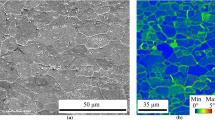Abstract
The deformation behavior of iron has been investigated at different temperatures by means of tension tests. There exist two temperature ranges for deformation. In the low-temperature range(T < 293 K), the flow stress σ, the work-hardening rate θ at ε = 0.06, and the yield stress σy decrease with increasing temperature, but in the higher temperature range(T ≥: 293 K), σ and θ at the same strain increase while σy decreases more slowly. The change of dislocation density, with temperature, atε = 0.06 exhibits the same tendency as that of the flow stress. The strainhardening rates decrease almost linearly with increasing stress up to necking in the low-temperature range, except the initial strain range. At the higher temperature range, the hardening rates decrease linearly with stress only at the early stage of deformation, but above certain strains, the decreases become more gradual; that is, the G-cr curves deviate from the linear region. The evolution of dislocation structure has also been observed by transmission electron microscopy (TEM). The results show that a substructural transition takes place in the nonlinear range of G-cr curves. In the linear decreasing region of strain-hardening curves, the deformation is controlled by the uniformly distributed dislocations or cell multiplication prevails. However, in the nonlinear region of G-cr curves, cell multiplication seems to be balanced by cell annihilation.
Similar content being viewed by others
References
U.F. Kocks:J. Eng. Mater. Technol. (ASME), 1976, vol. 98, pp. 76–85.
U.F. Kocks and H. Mecking: inStrength of Metals and Alloys, P. Haasen, V. Gerold, and G. Kostorz, eds., Pergamon Press, Oxford, United Kingdom, 1979, vol. 1, pp. 345–50.
H. Mecking and U.F. Kocks:Acta Metall., 1981, vol. 29, pp. 1865–75.
H. Mecking: inDislocation Modelling of Physical Systems, M.F. Ashby, R. Bullough, C.S. Hartley, and J.P. Hirth, eds., Pergamon Press, Oxford, United Kingdom, 1981, pp. 197–211.
J. Gil Sevillano, P. van Houtte, and E. Aernoudt: inProgress in Materials Science, J.W. Christian, P. Haasen, and T.B. Massalski, eds., Pergamon Press, New York, NY, 1981, vol. 25, pp. 69–412.
Y. Lan, H.J. Klaar, and W. Dahl:ScriptaMetall., 1990, vol. 24, pp. 337–42.
B. Sestak and A. Seeger:Z. Metallkd., 1978, vol. 69, pp. 355–63.
B. Sestak:Strength of Metals and Alloys, P. Haasen, V. Gerold, and G. Kostorz, eds., Pergamon Press, Oxford, United Kingdom, 1979, pp. 1461–82.
R.K. Ham:Phil. Mag., 1961, vol. 6, pp. 1183–84.
A.D. Rollett, U.F. Kocks, J.D. Embury, M.G. Stout, and R.D. Doherty: inStrength of Metals and Alloys, Proc. ICSMA-8, P.O. Kettunen, T.K. Lepistö, and M.E. Lehtonen, eds., Pergamon Press, New York, NY, 1988, vol. 8, pp. 433–38.
Y. Lan, H.J. Klaar, and W. Dahl:Scripta Metall., 1990, vol. 24, pp. 1659–64.
R.J. McElroy and Z.C. Szkopiak:Int. Met. Rev., 1972, vol. 17, pp. 175–202.
Y. Lan, H.J. Klaar, and W. Dahl:Metall. Trans. A, 1992, vol. 23A, pp. 545–49.
Author information
Authors and Affiliations
Rights and permissions
About this article
Cite this article
Lan, Y., Klaar, H.J. & Dahl, W. Evolution of dislocation structures and deformation behavior of iron at different temperatures: Part I. strain hardening curves and cellular structure. Metall Trans A 23, 537–544 (1992). https://doi.org/10.1007/BF02801171
Received:
Issue Date:
DOI: https://doi.org/10.1007/BF02801171



